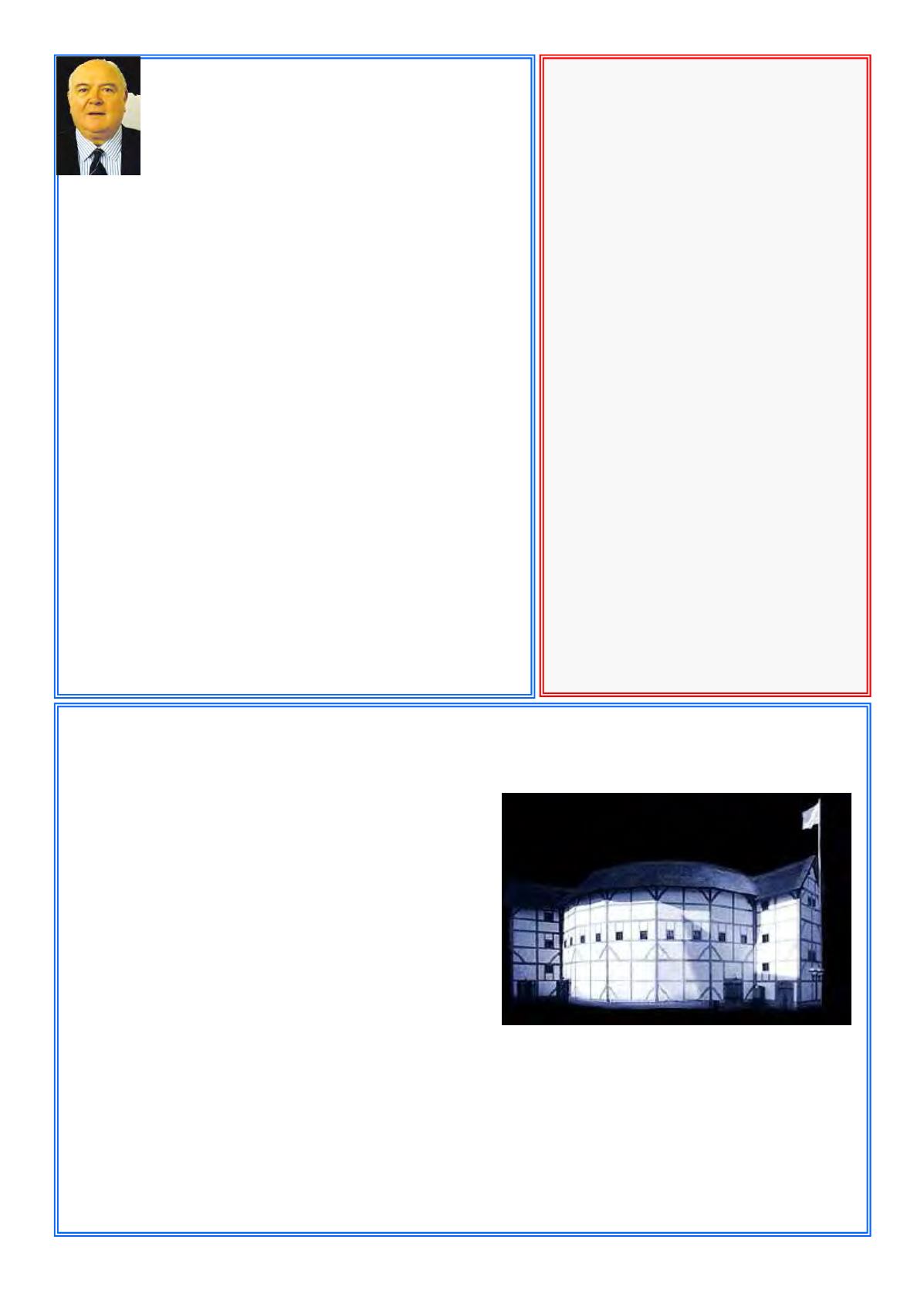

Visit to Globe Theatre -
Bryan Spearman
.
“On a very bright sunny day, the 1st of July to be precise, many members and guests of the Company availed them-
selves of an opportunity to visit Shakespeare's Globe theatre on
the South Bank of the Thames.
For those of you having not seen or experienced this venue, it
boasts, because of fire restrictions to be the only Thatched
building to have been given planning in London for many
years.
The construction of the current theatre in the round began in
1987 and was completed in 1997. Even this would not have
been possible but for Sam Wanamaker the American Actor and
Director who first visited in 1947 to find no lasting memorial
to Shakespeare and his theatre. In 1970 he formed the Shake-
speare Trust.
Our visit began with a guided tour giving everyone an opportunity to appreciate the history and background of
Shakespeare and his theatre. This was enhanced by a visit to the Exhibition centre which by the way is a focal point
for students, teachers and academics throughout the world.
The tour was concluded with a most pleasant lunch in the Globe Brassier before taking our seats, (not forgetting our
cushions)) to watch a splendid performance of “As you like It”
Formation of the Worshipful
Company of Firefighters
by Gerry Clarkson, Founder Master
In 1969 a young Station Officer took command of Cannon Street
Fire Station in the City of London. That Command experience
exposed him to the architecture and daily life of the City. He was
very influenced by the magical history, customs and pagentary of the City of Lon-
don. He marvelled that the craft or art of firefighting, which had been closely
entwined with the historical development of the City of London since the Roman
times, had not been recognised. And, given the very graphic part that fire has
played over the years in the City of London, he was amazed that there was no
Guild or Livery Company representing the Firefighters.
Over the ensuing years that Station Officer rose through all the ranks, until in
1987 he became the Chief Fire Officer of London. In his first year of office he
took the first steps to enquire how to set about forming such an association with
the City of London. In 1988 at a meeting held in the Court Room of Winchester
House a resolution was passed unanimously forming a Guild of Firefighters, being
representative of the Fire Service and the wider Fire Industry.
After the required interval of time, the Guild petitioned the Court of Mayor and
Aldermen of the Corporation of London to be admitted to the status of Company
without Livery. This was approved on 13th. June 1995. On the 22
nd
October
1997 – three hundred and thirty one years after the Great Fire of London – the
York Herald presented the Company with its new Coat of Arms. Following fur-
ther progress, on 23rd October 2001, in response to a Petition for Livery from the
Company of Firefighters, the Aldermanic Court of the City of London approved
the granting of Livery status. Thus the 103
rd
Livery Company in the City of Lon-
don was established.
The Worshipful Company of Firefighters formally received The Letters Patent
confirming the Grant of Livery from the Lord Mayor of London at the Mansion
House on the 17 January 2002. This important event was immediately following
by a Grand Luncheon in The Egyptian Hall at the Mansion House when the then
youngest Livery Company hosted the Lord Mayor, Aldermen, Sheriffs, and many
friends amongst the other Livery Companies.
The Origins of Livery
Companies
The Livery Companies of the City of London can
trace unbroken descent from mediaeval Trade
Guilds. The term “Guild” is said to derive from
the Saxon word “gild”, meaning a payment, as
members paid towards the cost of fellowship.
Guilds were craft or trade societies. They pro-
tected consumers and employers against incompe-
tence or fraud by training sufficient apprentices to
provide an
adequate supply of skilled craftsmen, selling
goods of true quality and weight. They helped
workers by preventing unlimited competition and
ensuring
reasonable wages and conditions. They searched
out inferior work and punished the offenders.
They settled trade and domestic disputes by arbi-
tration,
whilst their Halls served as centres for meetings
and recreation.
Members paid contributions as to a benefit soci-
ety, and then received relief when ill, infirm or
old, and had their burial expenses paid. There was
a strong religious element in the Guilds, each
adopting a patron Saint and being attached to a
local monastery or church.
The wearing of a livery arose from a practice of
wearing a distinctive form of dress on solemn or
festive occasions.
















